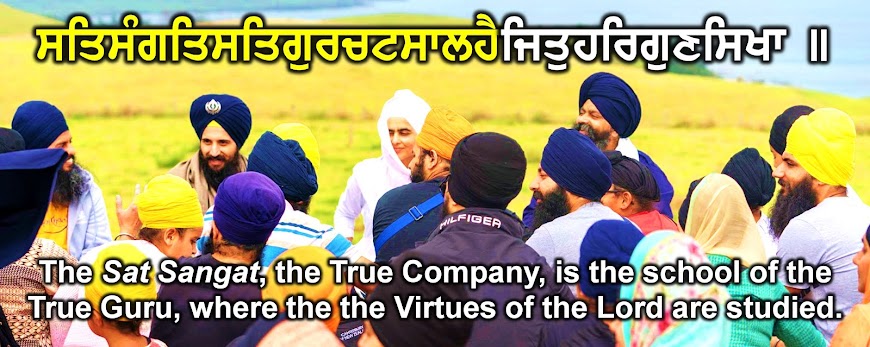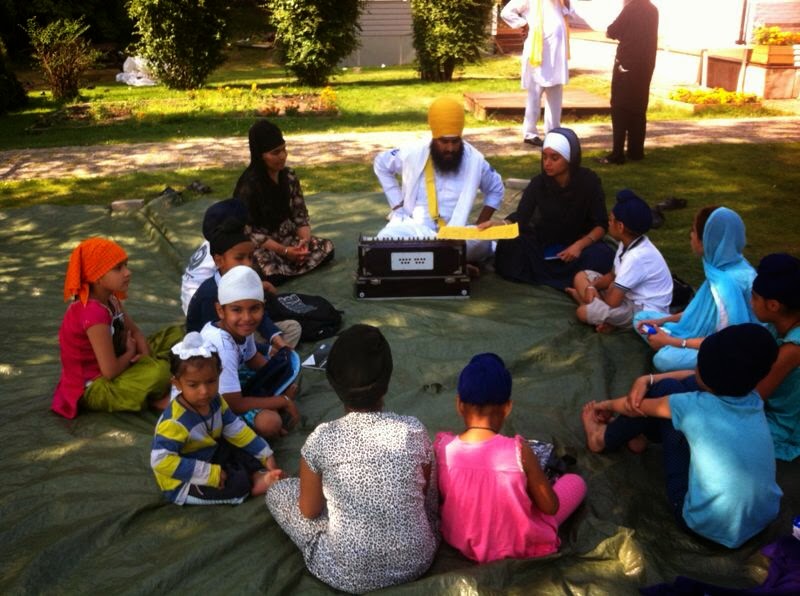The annual Sweden Sikh Family Camp was held at Gurdwara Sangat Sahib in Tullinge, Stockholm, from Monday 21st July to Sunday 27th July. The camp was attended by children and adults. Gursikhs from Denmark also attended the camp. The camp
seva was led by local
sevadaars as well as
sevadaars from UK and Amsterdam (Holland). The camp was a week of amazing
sangat,
amrit-vela, classes for adults and children, jokes and laughs, inspiration,
pyaar and
Naam rang. One child named Prabhjot Singh, aged 12, told Veer Jaskarn Singh (Holland),
"Bhajee this camp should not just be for one week, but for the whole year!" It was encouraging to know that the children really enjoyed the camp and didn't want the camp to end so soon.

It was worth sharing something about 7 year old Gursimrat Singh from UK who attended the camp with his family from Denmark. He showed great knowledge of Sikhi and also thirst for learning more. A very special child! He does a beautiful ardaas every time before he eats food. Also, he didn't eat bubble gum offered by another child, and also didn't eat pasta and pizza offered to him because he said he was ensure of the ingredients. Vaheguru! At the age of 7 he does full Nitnem (daily prayers) every day, ties his own dumallaa, and is very polite. Veer Jaskarn Singh (Holland) shared with me that after his history classes about 1978 and 1984 with Gursimrat Singh's group, when all the other children would go outside to play in the garden or eat Langar, he would ask Veer jee,
"Can I please stay longer with you to study? I want to study more... Can please you tell me more Saakhis?" He was very eager to learn more about the
jeevans of great Gursikhs. This is Guru's Kirpaa (Grace) and also the the hard work and investment that his parents have done to raise such a great Gursikh child.
There was one mona veer jee from India who had come to Sweden for a holiday with his wife. Veer jee shared with us that he usually never sits more longer than 15 minutes in the Gurdwara but during the camp was he sitting in the divaan for classes from 10.30am to 5pm. He also said that he never sat for listening Rehraas Sahib before. Veer jee was so interested and inspired by Sikh modern history that that he shared that he wished such camps where you can learn Gurbani and history were available in Panjab. He would after the camp ask questions and enjoy learning more about what was covered in the classes. Veer jee shared the sorry state of parchaar and gurdwaras in villages in Panjab. A nice thing to share is that Veer jee's daughter who was about 14 or so months old would keep repeating "Vaheguru" in such a deep and clear voice. She made the whole camp remember Vaheguru! Coincidentally the baby's name is "Gursimran Kaur".
Over the week camp there were classes on Sikh history (from 1849 to present day), teachings from Sri Guru Granth Sahib jee, Keertan, learning Panjabi and fundamental concepts of Sikhi such as Seva, Simran, Sangat, and sacrifice. As always it was a pleasure to work with the children and adults as they showed so much enthusiasm to learn. The atmosphere of the camp was great. The great weather, scenic Gurdwara surroundings and being in the Sangat of Gursikhs helped to make the camp great. On Sunday nearly all the children that attended the camp came ready
wearing dastaars and gurmukhi dress. Each group and child had to
present something to the Sangat that they had learnt from the camp. All
the children worked
really hard to get materials ready and were really excited to present
for the Sangat.
Some photos:
Amrit vela sunrise
Gurdwara Sahib with its beautiful garden
Workshop on Sangat with the 8 - 13 years old group, led by Veer Jaskarn Singh (Holland) and Bhenji Parubhjit Kaur (Holland)
The youngest group of campers
Veer Rajpal Singh (Holland) teaching the youngest group
Veer Jagdeep Singh (UK) teaching the middle group keertan
History class with the adults group

The youngest group learning to sing the Gurus names
Fun activities for young and old. "Grape and spoon race/game course."
Fun activities. Campers firing arrow to hit targets (not people - plastic cups!)
Musical chairs in Sikhi style - without chairs and everyone chanting Vaheguru!
Middle group class on Gurbani and how to respect Gurbani
Class on "Nindya" - slander. A very interesting class with the adults group led by Veer Jaskarn Singh (Holland), especially the scenario and group discussions at the end!
Group work in class about "nindya"

Watching the movie "Apnaa Mool Pachhaan". The movie had some really nice messages about Gurmat and Sikh history.
In the evening adults and sevadaars having fun in the Gurdwara garden (not sure of the name of the game)

Bheni Parubhjit Kaur (Holland) teaching the basics of Sikhi to youngest group
Children having fun outside
Children preparing for Sunday divaan
Veer Jagdeep Singh (UK) helping the middle group to prepare for their presentations for Sunday divaan
On the last day of the camp all the campers had a test - including the adults! The adults did the test in groups. They were tested on what they had learnt in the history classes which covered Sikh history from 1849 to present day. It was good to know that the adults had paid attention and remembered key information from the classes.
Sunday divaan Sangat
Guru jee
Sunday divaan - Keertan by Veer Rajpal Singh (Holland). Veer jee beautifully sung a Shabad of Guru Gobind Singh jee from Dasam Granth: ਪ੍ਰਾਨ ਕੇ ਬਚ੍ਯਾ ਦੂਧ ਪੂਤ ਕੇ ਦਿਵ੍ਯਾ ਰੋਗ ਸੋਗ ਕੇ ਮਿਟ੍ਯਾ ਕਿਧੌ ਮਾਨੀ ਮਹਾ ਮਾਨ ਹੋ || "praan ke bachya doodh poot ke divyaa rog sog ke mittyaa kidho maanee mahaa maan ho." ("You are the Saviour of life. The provider of milk and offspring, the eradicator of suffering and grief, and are venerable and deserve high esteem.")
Sunday divaan - youngest group of children sing "Aagya Bhe-ee Akaal Kee..." and sing all the Gurus names to the Sangat
A young camper reciting Mool Mantar paatth to the Sangat
Bhenji aged 5 and Veer jee aged 6 reciting the Gurus names to the Sangat
Sehajneet Singh, Gurpreet Kaur and Bhavdeep Kaur presenting what they have learnt about 1986 Sarbat Khalsa and Operations Black Thunder I and II.
This group talked about the history of the 1978 Amritsar massacre. The young Singh speaking on the microphone was reciting the poem 'Kurbani' written by Shaheed Bhai Fauja Singh jee.
Veer jee presenting some facts about modern Sikh history he learnt at the camp has short cut hair but he showed great enthusiasm in learning about Sikhi and Sikh history.
The child pictured above came late to the Sunday divaan and missed the presentations that the young campers did, but he requested at the end if he could speak. He recited the Gurus names in Sangat having learnt them during
the camp. This shows the effort that the children put in and the fact that
having the opportunity had a really positive effect on them. When Veer Jasdeep Singh (UK) gave
him Panjabi work and other things to do in class, he would go home and
do extra and then give it to him the next day, even if he didn't tell him
to. This illustrates the dedication and thirst for Sikhi of the children.
Bhai Sajjan Singh jee, local main sevadaar, thanking the Sangat at the end
Sangat group photo
Dhan Hai Guru! Dhan Hai Teree Sikhee!












.JPG)



.jpg)
.jpg)










































